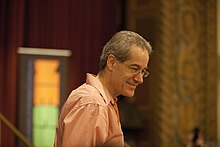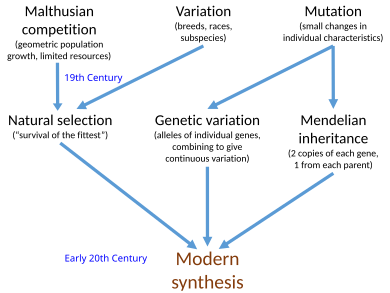확장된 진화 합성
Extended evolutionary synthesis| 시리즈의 일부 |
| 진화생물학 |
|---|
 |
확장된 진화 합성은 1918년에서 1942년 사이에 일어난 진화 생물학의 초기 현대 합성보다 더 포괄적이라고 주장되는 일련의 이론적 개념으로 구성됩니다.1950년대에 C에 의해 확장된 진화 합성이 요구되었다. H. 와딩턴은 1980년대에 스티븐 제이 굴드와 닐스 엘드레지에 의해 단절된 평형을 기반으로 주장되었고, 2007년에 마시모 피글리우치와 게르트 B에 의해 재인식화 되었다. 뮐러.특히, 뮐러 박사는 이 연구에서 자연선택은 종분화를 설명할 방법이 없다고 결론지었다. "선택에는 혁신적인 능력이 없다...따라서 형태학적 진화의 생성적 측면과 순서적 측면은 진화 이론에서 존재하지 않는다."
확장된 진화 합성은 작용 중인 다른 요인의 상대적 중요성을 재검토하고, 초기 합성의 몇 가지 가정을 검사하고, 추가적인 원인 [1][2]인자로 그것을 증가시킨다.다단계 선택, 세대간 후생유전, 틈새구성, 진화 가능성 및 진화발달생물학의 [3][4][5][6]몇 가지 개념을 포함한다.
모든 생물학자들이 확장된 합성의 필요성 또는 범위에 동의한 것은 아니다.많은 이들이 진화발달생물학의 또 다른 합성에 협력하고 있는데, 이것은 고도로 보존된 유전자 수준에서 유기체 간의 발달 과정과 깊은 호몰로지에 대해 자연 선택이 어떻게 작용하는지 이해하기 위해 발달 분자 유전학과 진화에 초점을 맞추고 있다.
앞의 '현대 합성'
현대적 합성은 찰스 다윈의 자연 도태에 의한 진화 이론과 그레고르 멘델의 유전학 이론을 공통의 수학적 틀에서 조화시키는 20세기 초에 널리 받아들여진 합성이었다.그것은 진화를 생물학의 중심 패러다임으로 확립했다.다윈과 멘델의 유전학에 의한 19세기 자연 도태 사상은 1918년에서 [7][8][9][10]1932년 사이에 집단 유전학의 창시자 중 한 명인 로널드 피셔와 J. B. S. 홀데인과 시월 라이트를 포함한 연구자들에 의해 결합되었다.줄리언 헉슬리는 1942년 저서 '진화: 모던 [11][12][13]합성.
초기 역사
1950년대에 영국의 생물학자 C. H. Waddington은 후생유전학과 유전자 [14][15][16]동화에 대한 그의 연구를 바탕으로 확장된 합성을 요구했다.오스트리아 동물학자 루퍼트 리들(Rupert Riedl)도 진화 가능성에 [17]대한 연구를 통해 확장된 합성법을 제안했다.1978년, 마이클 J. D. 화이트는 [18]분화로부터 새로운 연구를 바탕으로 현대 합성의 연장에 대해 썼다.
1980년대: 중단 평형
1980년대에, 미국의 고생물학자 스티븐 제이 굴드와 나일스 엘드레지는 단절된 균형, 대규모 진화 패턴을 형성하는 종 선택의 역할, 그리고 유전자에서 [19][20][21][22]종으로 확장되는 다단계에서의 자연 도태에 대한 그들의 생각에 근거해 확장된 합성을 주장했다.동물행동학자 존 엔들러는 1988년에 그가 [23]무시당했다고 느꼈던 진화의 과정을 논하는 논문을 썼다.
진화발달생물학의 기여
진화발달생물학 분야의 일부 연구자들은 또 다른 합성을 제안했다.그들은 현대적이고 확장된 합성들은 대부분 유전자에 초점을 맞춰야 하며 고도로 보존된 유전자, 전사 인자 그리고 신호 전달 패턴의 수준에서 유전자 조절과 유기체 사이의 깊은 호몰로지에 자연 선택이 어떻게 작용하는지를 이해하는 것을 목표로 하여 분자 유전학과 진화와 배아학의 통합을 제안해야 한다고 주장한다.Hways.[24][5]이와는 대조적으로,evo-devo의 유기체의 approach[25][26][27][28][29][30]확장 융합에 주요 요인으로 진화에( 다른 사람들 사이에서)발달 bias[31일]( 통해 facilitation[32]과 constraint[33]), evolvability,[34][35]과 형태[36][37]의 본래의 속성을 강조함으로써 기여한 이후 다른 가닥 o.F 복잡한 구조와 표현형 특이한 물건.[38][39]
최근 이력

확장 합성 아이디어는 마시모 피글리우치와 [40][41][42]게르트 B에 의해 2007년에 다시 시작되었습니다. 뮐러,[28][42] 2010년 '진화: 확장 합성(Extended Synthesis)은 확장 [42]합성 작업의 시작점이 되어 왔습니다.여기에는 다음이 포함됩니다.
- 진화적 [43][44]변이를 발생시키는 데 있어 유기체의 이전 구성, 게놈 구조 및 기타 특성들의 역할.
- 피트니스 환경의 증가된 차원이 우리의 [42]특화 관점에 어떻게 영향을 미치는가.
- 주요 진화적 [42]전환에서 다단계 선택의 역할.
- 문화적,[45][46] 후생적 유산을 포함한 새로운 형태의 유산.
- 생물 발달과 발육 가소성이 진화 경로를[47][31][33] 통해 표현형[38][39][48] 참신성을 생성하는 방법
- 틈새 [5][2]건축을 통해 유기체가 속한 환경을 어떻게 변화시키는지.
진화 가능성, 표현형 가소성, 망상 진화, 성 진화[49], 공생과 같은 다른 과정들은 현대 [50][51]합성에서 제외되거나 누락되었다고 지지자들에 의해 말한다.Piglucci와 Muller의 확장된 합성의 목표는 집단 유전학의 유전자 중심 접근법을 넘어 더 유기체 중심적이고 생태 중심적인 접근을 고려하는 것이다.이러한 원인들 중 많은 것들이 현재 진화적 원인에서 이차적인 것으로 간주되고 있으며, 확장 합성의 지지자들은 그것들이 1급 진화적 [52]원인으로 간주되기를 원한다.생물학자인 유진 쿠닌은 2009년에 "진화생물학의 새로운 발전은 결코 다윈에 대한 반박으로 여겨져서는 안 된다.오히려 다윈이 150년 전에 개척했던 발자취를 넓히고 그의 사고방식의 [53]비범한 풍요로움을 드러내고 있습니다.
예측
확장 합성은 표준 현대 합성 이론과 다른 추가 예측 집합으로 특징지어진다.
- 유전자형의[4] 변화보다 표현형의 변화가 선행할 수 있다
- 표현형의 변화는 중성보다는 주로 긍정적이다(참조: 분자진화의 중성 이론).
- 표현형의 변화는 하나의[4] 유기체보다는 많은 유기체에서 유발된다
- 표현형의 혁명적인 변화는 돌연변이, 촉진된[4] 변화 또는 역치[39][54] 이벤트를 통해 발생할 수 있다
- 고립된 집단에서의 반복적인 진화는 수렴적인 진화 또는 발달적[4][31] 편견에 의해 이루어질 수 있다
- 적응은 자연선택, 환경유도, 비유전적 유전, 학습 및 문화적 전달에 의해 야기될 수 있다(Baldwin 효과, 밈, 전세대 후생유전적 유전, 생태적 유전,[4] 비멘델적 유전 참조).
- 빠른 진화는 동시 유도, 자연[4] 선택 및 발달[55] 역학에 의해 발생할 수 있다.
- 생물 다양성은 진화[4] 가능성의 차이와 같은 개발 시스템의 특징에 의해 영향을 받을 수 있다.
- 유전적인 변화는 적응적이고 표현형과[4] 통합된 변형을 지향한다
- 틈새 건설은 건설자의 표현형, 또는 그 후손의 표현형에 맞는 환경 변화에 편중되어 그들의[2] 적합성을 강화한다.
- 친족 선택[3]
- 다단계 선택[4]
- 자기 조직화[40][56]
테스트
확장된 진화 합성은 현재 영국, 스웨덴, 미국의 8개 기관의 과학자 그룹에 의해 시험되고 있다.770만 파운드의 프로젝트는 존 템플턴 [57][58]재단의 570만 파운드의 보조금으로 지원되고 있다.
이 프로젝트는 St Andrews 대학의 Kevin N. Laland와 Lund 대학의 Tobias Uller가 이끌고 있습니다.Laland에 따르면 확장 합성이 "실제로 요약되는 것은 선택, 표류, 돌연변이 및 기타 확립된 진화 과정 외에 다른 요인들, 특히 발달적 영향들이 중요한 방식으로 진화 과정을 형성한다는 인식이다."[59]
상황
생물학자들은 확장된 합성의 필요성에 대해 동의하지 않는다.반대론자들은 현대 합성이 새로운 관찰을 충분히 설명할 수 있다고 주장하는 반면, 다른 사람들은 확장 합성이 충분히 [60]급진적이지 않다고 비판한다.찬성론자들은 현대 합성의 핵심에 있는 진화의 개념이 너무[61] 좁고 현대 합성이 확장된 합성의 아이디어를 허용하더라도, 현대 합성을 사용하는 것은 생물학자들이 진화에 대해 생각하는 방식에 영향을 미친다고 생각합니다.예를 들어, 데니스 노블은 현대 합성 용어와 범주를 사용하는 것은 현대 실험이 발견한 [62]생물학의 그림을 왜곡시킨다고 말한다.따라서 지지자들은 진화가 생물학적 학문 [2][63]전반에 걸쳐 고려되는 방법의 개념과 틀을 확장하는 데 있어 확장된 합성이 필요하다고 주장한다.
레퍼런스
- ^ Wade, Michael J. (2011). "The Neo-Modern Synthesis: The Confluence of New Data and Explanatory Concepts". BioScience. 61 (5): 407–408. doi:10.1525/bio.2011.61.5.10.
- ^ a b c d Laland, Kevin N.; Uller, Tobias; Feldman, Marcus W.; Sterelny, Kim; Müller, Gerd B.; Moczek, Armin; Jablonka, Eva; Odling-Smee, John (2015-08-22). "The extended evolutionary synthesis: its structure, assumptions and predictions". Proc. R. Soc. B. 282 (1813): 20151019. doi:10.1098/rspb.2015.1019. PMC 4632619. PMID 26246559.
- ^ a b Danchin, É.; Charmantier, A.; Champagne, F. A.; Mesoudi, A.; Pujol, B.; Blanchet, S (2011). "Beyond DNA: integrating inclusive inheritance into an extended theory of evolution". Nature Reviews Genetics. 12 (7): 475–486. doi:10.1038/nrg3028. PMID 21681209. S2CID 8837202.
- ^ a b c d e f g h i j Pigliucci, Massimo; Finkelman, Leonard (2014). "The Extended (Evolutionary) Synthesis Debate: Where Science Meets Philosophy". BioScience. 64 (6): 511–516. doi:10.1093/biosci/biu062.
- ^ a b c Laubichler, Manfred D.; Renn, Jürgen (2015). "Extended evolution: A Conceptual Framework for Integrating Regulatory Networks and Niche Construction". Journal of Experimental Zoology Part B: Molecular and Developmental Evolution. 324 (7): 565–577. doi:10.1002/jez.b.22631. PMC 4744698. PMID 26097188.
- ^ Müller, Gerd B. (December 2007). "Evo–devo: extending the evolutionary synthesis". Nature Reviews Genetics. 8 (12): 943–949. doi:10.1038/nrg2219. PMID 17984972. S2CID 19264907.
- ^ National Academy of Sciences (1999). Science and Creationism: A View from the National Academy of Sciences (2nd ed.). Washington, D.C.: National Academy Press. p. 28. doi:10.17226/6024. ISBN 978-0-309-06406-4. LCCN 99006259. OCLC 43803228. PMID 25101403.
The scientific consensus around evolution is overwhelming.
- ^ Bock, Walter J. (July 1981). "Reviewed Work: The Evolutionary Synthesis. Perspectives on the Unification of Biology". The Auk. 98 (3): 644–646. ISSN 0004-8038. JSTOR 4086148.
- ^ Fisher, Ronald A. (January 1919). "XV.—The Correlation between Relatives on the Supposition of Mendelian Inheritance". Transactions of the Royal Society of Edinburgh. 52 (2): 399–433. doi:10.1017/S0080456800012163. ISSN 0080-4568. OCLC 4981124. 1918년 7월 8일 J. 아서 톰슨이 에든버러 왕립협회에 보낸 논문.
- ^ Fisher, R. A. (1999) [Originally published 1930; Oxford, UK: The Clarendon Press]. The Genetical Theory of Natural Selection. Edited with a foreword and notes by J. H. Bennett (A complete variorum ed.). Oxford, UK: Oxford University Press. ISBN 978-0-19-850440-5. LCCN 00702764. OCLC 45308589.
- ^ Hubbs, C.L. (1943). "Evolution the new synthesis". American Naturalist. 77 (771): 365–68. doi:10.1086/281134.
- ^ Kimball, R.F. (1943). "The great biological generalization". Quarterly Review of Biology. 18 (4): 364–67. doi:10.1086/394682. S2CID 88212178.
- ^ Karl P. Schmidt, 줄리안 헉슬리의 현대 합성 진화, 1943년 제4권, 제262-263페이지
- ^ Wilkins, Adam S (2008). "Waddington's Unfinished Critique of Neo-Darwinian Genetics: Then and Now". Biological Theory. 3 (3): 224–232. doi:10.1162/biot.2008.3.3.224. S2CID 84217300.
- ^ Pigliucci, Massimo; et al. (2006). "Phenotypic plasticity and evolution by genetic assimilation". Journal of Experimental Biology. 209 (12): 2362–2367. doi:10.1242/jeb.02070. PMID 16731812.
- ^ Huang S. (2011년)워딩턴의 후생학적 풍경의 분자적, 수학적 기초: 다르윈 이후의 생물학을 위한 틀?BioEssays 34: 149-157.
- ^ 바그너, 귄터 P, 라우빌러, 만프레드 D. (2004)"루퍼트 리델과 진화생물학과 발달생물학의 재합성: 차체 계획과 진화 가능성" 2015-12-08년 웨이백 머신에 보관.실험동물학 저널(몰 데브 에볼루션) 302B: 92-102.
- ^ 파넬, 데니스 R.(1978)M. J. D.에 의한 새로운 합성 모드의 예고. 흰색, 식물학 체계화제3권 제1페이지 126
- ^ 굴드, 스티븐 제이(1980).새로운 일반 진화 이론이 등장하고 있는가?고생물학.제6권, 제1권. 페이지 119-130
- ^ Gould, Stephen Jay (1982). "Darwinism and the Expansion of Evolutionary Theory". Science. 216 (4544): 380–387. Bibcode:1982Sci...216..380G. doi:10.1126/science.7041256. PMID 7041256.
- ^ '모어 모던 합성'미국의 과학자.
- ^ Vermeij, Geerat J (1987). "Unfinished Synthesis: Biological Hierarchies and Modern Evolutionary Thought by Niles Eldredge". The Quarterly Review of Biology. 62 (1): 79–80. doi:10.1086/415312.
- ^ Endler, John A; McLellan, Tracy (1988). "The Processes of Evolution: Toward a Newer Synthesis". Annual Review of Ecology and Systematics. 19: 395–421. doi:10.1146/annurev.es.19.110188.002143. JSTOR 2097160.
- ^ Davidson, Eric H. (2006). The regulatory genome : gene regulatory networks in development and evolution. Amsterdam [Netherlands]. ISBN 978-0120885633. OCLC 61756485.
- ^ Bateson, P (2005). "The Return of the Whole Organism". Journal of Biosciences. 30 (1): 31–39. doi:10.1007/bf02705148. PMID 15824439. S2CID 26656790.
- ^ Huneman, Philippe (2010). "Assessing the Prospects for a Return of Organisms in Evolutionary Biology". History and Philosophy of the Life Sciences. 32 (2–3): 341–372. PMID 21162374.
- ^ Gilbert, S.F.; Opitz, G.; Raff, R. (1996). "Resynthesizing Evolutionary and Developmental Biology". Developmental Biology. 173 (2): 357–372. doi:10.1006/dbio.1996.0032. PMID 8605997.
- ^ a b Müller, G. B. (2007). "Evo-devo: Extending the evolutionary synthesis". Nature Reviews Genetics. 8 (12): 943–949. doi:10.1038/nrg2219. PMID 17984972. S2CID 19264907.
- ^ '형식의 기원'자연사
- ^ Hall, Brian K. (1998). Evolutionary developmental biology (2nd ed.). London: Chapman & Hall. ISBN 978-0412785801. OCLC 40606316.
- ^ a b c Brakefield, Paul M. (July 2006). "Evo-devo and constraints on selection". Trends in Ecology & Evolution. 21 (7): 362–368. doi:10.1016/j.tree.2006.05.001. ISSN 0169-5347. PMID 16713653.
- ^ Gerhart, John; Kirschner, Marc (2007-05-15). "The theory of facilitated variation". Proceedings of the National Academy of Sciences. 104 (suppl 1): 8582–8589. Bibcode:2007PNAS..104.8582G. doi:10.1073/pnas.0701035104. PMC 1876433. PMID 17494755.
- ^ a b Smith, J. Maynard; Burian, R.; Kauffman, S.; Alberch, P.; Campbell, J.; Goodwin, B.; Lande, R.; Raup, D.; Wolpert, L. (September 1985). "Developmental Constraints and Evolution: A Perspective from the Mountain Lake Conference on Development and Evolution". The Quarterly Review of Biology. 60 (3): 265–287. doi:10.1086/414425. ISSN 0033-5770. S2CID 85201850.
- ^ Wagner, Günter P.; Altenberg, Lee (June 1996). "Perspective: Complex Adaptations and the Evolution of Evolvability". Evolution. 50 (3): 967–976. doi:10.1111/j.1558-5646.1996.tb02339.x. ISSN 0014-3820. PMID 28565291. S2CID 21040413.
- ^ Huneman, Philippe; Walsh, Denis M. (2017-08-17). Challenging the modern synthesis : adaptation, development, and inheritance. Huneman, Philippe,, Walsh, Denis M., 1958-. New York, NY. ISBN 9780199377183. OCLC 1001337947.
- ^ Newman, Stuart A.; Müller, Gerd B. (2006-01-06), "Genes and Form", Genes in Development, Duke University Press, pp. 38–73, doi:10.1215/9780822387336-003, ISBN 9780822387336
- ^ Newman, Stuart A. (2017-11-15), "Inherency", Evolutionary Developmental Biology, Springer International Publishing, pp. 1–12, doi:10.1007/978-3-319-33038-9_78-1, ISBN 9783319330389
- ^ a b Müller, Gerd B. (2010-03-26), "Epigenetic Innovation", Evolution—the Extended Synthesis, The MIT Press, pp. 307–333, doi:10.7551/mitpress/9780262513678.003.0012, ISBN 9780262513678, retrieved 2018-06-22
- ^ a b c Peterson, Tim; Müller, Gerd B. (2016-04-28). "Phenotypic Novelty in EvoDevo: The Distinction Between Continuous and Discontinuous Variation and Its Importance in Evolutionary Theory". Evolutionary Biology. 43 (3): 314–335. doi:10.1007/s11692-016-9372-9. ISSN 0071-3260. PMC 4960286. PMID 27512237.
- ^ a b Pigliucci, Massimo (2007). "Do We Need an Extended Evolutionary Synthesis?". Evolution. 61 (12): 2743–2749. doi:10.1111/j.1558-5646.2007.00246.x. PMID 17924956. S2CID 2703146.
- ^ Grant, Bob (1 January 2010). "Should Evolutionary Theory Evolve". The Scientist.
- ^ a b c d e Pigliucci, Massimo; Müller, Gerd B., eds. (26 March 2010). Evolution - the Extended Synthesis. The MIT Press. ISBN 978-0262513678.
- ^ Meaden, Rhiannon (5 August 2015). "Redefining Evolutionary Biolog". The Royal Society Publishing Blog.
- ^ Indiana University (7 August 2015). "Expanding the Theory of Evolution". Lab Manager.
- ^ Bonduriansky, R; Day, T (2009). "Nongenetic inheritance and its evolutionary implications" (PDF). Annual Review of Ecology and Systematics. 40: 103–125. doi:10.1146/annurev.ecolsys.39.110707.173441.
- ^ Schrey; et al. (15 December 2011). "The Role of Epigenetic in Evolution: the Extended Synthesis". Genetics Research International. 2012: 286164. doi:10.1155/2012/286164. PMC 3335599. PMID 22567381.
- ^ Stotz, Karola (20 August 2014). "Extended evolutionary psychology: the importance of transgenerational developmental plasticity". Frontiers in Psychology. 5: 908. doi:10.3389/fpsyg.2014.00908. PMC 4138557. PMID 25191292.
- ^ Moczek, Armin P. (2011-05-05). "Evolutionary biology: The origins of novelty". Nature. 473 (7345): 34–35. Bibcode:2011Natur.473...34M. doi:10.1038/473034a. PMID 21544136. S2CID 4413435.
- ^ Lodé, Th (2011). "Sex is not a solution for reproduction, the libertine bubble theory". BioEssays. 33 (6): 419–422. doi:10.1002/bies.201000125. PMID 21472739. S2CID 12345977.
- ^ Perez, JUlio E; Alfonsi, Carmen; Munoz, Carlos (2010). "Towards a New Evolutionary Theory" (PDF). Interciencia. 35: 862–868.
- ^ 곤티에, 나탈리(2015).모든 곳에서 진화를 재현합니다. 레티큘레이트 진화: 공생, 측방향 유전자 이동, 잡종화 및 전염성 유전.스프링거 페이지 1~40ISBN 978-3-319-16344-4
- ^ "Expanding Theory of Evolution". PhysOrg. 5 August 2015.
- ^ Koonin, Eugene (2009). "Towards a postmodern synthesis of evolutionary biology". Cell Cycle. 8 (6): 799–800. doi:10.4161/cc.8.6.8187. PMC 3410441. PMID 19242109.
- ^ Lange, Axel; Nemeschkal, Hans L.; Müller, Gerd B. (April 2018). "A threshold model for polydactyly". Progress in Biophysics and Molecular Biology. 137: 1–11. doi:10.1016/j.pbiomolbio.2018.04.007. ISSN 0079-6107. PMID 29739620.
- ^ Favé, Marie-Julie; Johnson, Robert A.; Cover, Stefan; Handschuh, Stephan; Metscher, Brian D.; Müller, Gerd B.; Gopalan, Shyamalika; Abouheif, Ehab (2015-09-04). "Past climate change on Sky Islands drives novelty in a core developmental gene network and its phenotype". BMC Evolutionary Biology. 15 (1): 183. doi:10.1186/s12862-015-0448-4. ISSN 1471-2148. PMC 4560157. PMID 26338531.
- ^ Johnson, BR; Lam, SK (2010). "Self-Organization, Natural Selection, and Evolution: Cellular Hardware and Genetic Software". BioScience. 60 (11): 879–885. doi:10.1525/bio.2010.60.11.4. S2CID 10903076.
- ^ "Should Evolutionary Theory Evolve". University of Southampton. 7 April 2016.
- ^ Laland, Kevin (21 December 2016). "Launching the Extended Evolutionary Synthesis project". Nature Research Ecology & Evolution Community.
- ^ "확장 진화 합성 강화"진화 연구소.
- ^ Craig, Lindsay R. (June 2010). "The So-Called Extended Synthesis and Population Genetics". Biological Theory. 5 (2): 117–123. doi:10.1162/biot_a_00035. ISSN 1555-5542. S2CID 84662773.
- ^ Laland, Kevin, Tobias Uller, Marc Feldman, Kim Sterelny, Gerd B. Müller, Armin Moczek, Eva Jablonka, John Odling-Smee, Gregory A. Wray, Hopi E. Hoekstra, Douglas J. Futuyma, Richard E. Lenski, Trudy F. C. Mackay, Dolph Schluter & Joan E. Strassmann; et al. (8 October 2014). "Does Evolutionary Theory Need a Rethink?". Nature. 514 (7521): 161–164. Bibcode:2014Natur.514..161L. doi:10.1038/514161a. PMID 25297418.
{{cite journal}}: CS1 maint: 여러 이름: 작성자 목록(링크) - ^ Noble, Denis (1 January 2015). "Evolution Beyond Neo-Darwinism: A New Conceptual Framework". The Journal of Experimental Biology. 218 (Pt 1): 7–13. doi:10.1242/jeb.106310. PMID 25568446.
- ^ Müller, Gerd B. (2017-10-06). "Why an extended evolutionary synthesis is necessary". Interface Focus. 7 (5): 20170015. doi:10.1098/rsfs.2017.0015. ISSN 2042-8898. PMC 5566817. PMID 28839929.
추가 정보
확장 합성 방어
- Arnold, Anthony J; Fristrup, Kurt (1982). "The Theory of Evolution by Natural Selection: A Hierarchical Expansion". Paleobiology. 8 (2): 113–129. doi:10.1017/s0094837300004462.
- Boto, Luis (2010). "Horizontal Gene Transfer in Evolution: Facts and Challenges". Proc Biol Sci. 277 (1683): 819–827. doi:10.1098/rspb.2009.1679. PMC 2842723. PMID 19864285.
- Carroll, Sean B (2008). "Evo-Devo and an Expanding Evolutionary Synthesis: A Genetic Theory of Morphological Evolution". Cell. 134 (1): 25–36. doi:10.1016/j.cell.2008.06.030. PMID 18614008. S2CID 2513041.
- Endler, John (1986). "The Newer Synthesis? Some Conceptual Problems in Evolutionary Biology". Oxford Surveys in Evolutionary Biology. 3: 224–243.
- 길버트, 스콧 F. (2000)'새로운 진화론 합성'발달 생물학 제6판입니다시나우어.ISBN 0-87893-243-7
- Jablonka, Eva; Lamb, Marion J. (2008). "Soft Inheritance: Challenging the Modern Synthesis". Genetics and Molecular Biology. 31 (2): 389–395. doi:10.1590/s1415-47572008000300001.
- Koonin, Eugene (2009). "Towards a postmodern synthesis of evolutionary biology". Cell Cycle. 8 (6): 799–800. doi:10.4161/cc.8.6.8187. PMC 3410441. PMID 19242109.
- Koonin, Eugene (2009). "The Origin at 150: is a new evolutionary synthesis in sight?". Trends Genet. 25 (11): 473–475. doi:10.1016/j.tig.2009.09.007. PMC 2784144. PMID 19836100.
- 로데, 티에리(2013).마니페스트는 에콜로지 에볼라를 쏟아부어라, 다윈 등.에드 오딜 제이콥, 파리
- 메시리, J.G. (1992)피아제의 진화 개념: 다윈과 라마르크 너머로.Lanham, MD: Rowman & Littlefield.ISBN 0-8476-8243-9.
- Müller, Gerd B. (2014). "EvoDevo Shapes the Extended Synthesis". Biol Theory. 9 (2): 119–121. doi:10.1007/s13752-014-0179-6.
- Pennisi, Elizabeth (2008). "Modernizing the Modern Synthesis". Science. 321 (5886): 196–197. doi:10.1126/science.321.5886.196. PMID 18621652. S2CID 33015565.
- 포스트다위니즘: "새로운 합성"생태발달생물학 리뷰:Scott F의 후생유전학, 의학 및 진화 통합.길버트와 데이비드 에펠(시나우어, 2009).
- 포스트모던 합성?Mary Jane West-Eberhard의 Developmental Plasticity and Evolution 리뷰(Oxford University Press, 2003).
- Schrey; et al. (2012). "The Role of Epigenetics in Evolution: The Extended Synthesis". Genetics Research International. 2012: 286164. doi:10.1155/2012/286164. PMC 3335599. PMID 22567381.
- Weber, Bruce H (2011). "Extending and Expanding the Darwinian Synthesis: The Role of Complex Systems Dynamics". Studies in History and Philosophy of Biological and Biomedical Science. 42 (1): 75–81. doi:10.1016/j.shpsc.2010.11.014. PMID 21300318.
- Whitfield, John (2008). "Biology theory: Postmodern evolution?". Nature. 455 (7211): 281–284. doi:10.1038/455281a. PMID 18800108.
확장 합성에 대한 비판
- Coyne, Jerry (November 24, 2014). "Does evolution need a revolution?". Why Evolution Is True (Blog). Retrieved 2015-11-19.
- Craig, Lindsay (2010). "The So-Called Extended Synthesis and Population Genetics". Biological Theory. 5 (2): 117–123. doi:10.1162/biot_a_00035. S2CID 84662773.
- 디킨스, 토마스, 라만, 카지(2012)."확장된 진화적 합성과 진화에서 소프트 유전의 역할"왕립학회 절차: B 생물과학, 279(1740). 페이지 2913–2921.
- Felsenstein, Joseph (1986). "Waiting for Post-Neo-Darwin". Evolution. 40 (4): 883–889. doi:10.2307/2408480. JSTOR 2408480. PMID 28556149.
- Haig, David (2007). "Weismann rules! OK? Epigenetics and the Lamarckian Temptation". Biology and Philosophy. 22 (3): 415–428. doi:10.1007/s10539-006-9033-y. S2CID 16322990.
- Kurland, CG; Canback, B; Berg, OG (2003). "Horizontal Gene Transfer: A Critical View". Proc Natl Acad Sci U S A. 100 (17): 9658–9662. Bibcode:2003PNAS..100.9658K. doi:10.1073/pnas.1632870100. PMC 187805. PMID 12902542.
- Lynch, Michael (2007). "The frailty of adaptive hypotheses for the origins of organismal complexity". Proceedings of the National Academy of Sciences. 104: 8597–8604. Bibcode:2007PNAS..104.8597L. doi:10.1073/pnas.0702207104. PMC 1876435. PMID 17494740.
- Mayr, Ernst (2004). "80 years of watching the evolutionary scenery". Science. 305 (5680): 46–47. doi:10.1126/science.1100561. PMID 15232092.
- Merlin, Francesca (2010). "Evolutionary Chance Mutation: A Defense of the Modern Synthesis' Consensus View". Philosophy and Theory in Biology. 2 (20170609): 22. doi:10.3998/ptb.6959004.0002.003.
- Stebbins, Ledyard G.; Ayala, Francisco J. (1981). "Is a New Evolutionary Synthesis Necessary?". Science. 213 (4511): 967–971. Bibcode:1981Sci...213..967L. doi:10.1126/science.213.4511.967. PMID 17789015. S2CID 39048630.




